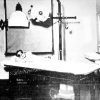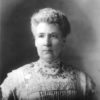calsfoundation@cals.org
Dr. H. A. Longino House
The Dr. H. A. Longino House, built in 1910, is located at 317 West Main Street and is within the original plat of the city of Magnolia (Columbia County). It sits two blocks west of the Magnolia city square and faces Main Street to the north and Vine (originally Boundary Street) Street to the west. The approximately 3,850-square-foot structure has two stories and a basement. The house and two outbuildings occupy one and a half original lots. The home was designed by Texarkana (Miller County) architect Eugene C. Seibert.
Dr. Henry Alvan Longino and his wife, Ellen, moved to Magnolia from Homer, Louisiana, several years prior to building the house. Ellen Longino died before the house was completed.
Dr. Longino was in partnership with other investors in a local pharmacy named Longino, Goode, and Lyle that operated on the Magnolia square. He became a successful businessman and made several business and property investments in the local area, being the original owner of the county property known as “Logoly” that would later become Logoly State Park (the name comprising the first two letters of Longino, Goode, and Lyle).
The house is covered with a salmon brick veneer and has a low-pitched hip roof and central dormer. It features an imported Italian terra cotta tile roof with small paned windows on the second level. The home has a large beveled-glass entrance door, with matching sidelights and transom, and includes French doors with sidelights and matching transom that open onto the balcony on the second level.
The design of the house represents a transition from the typical American turn-of-the-century Revival style to a more Craftsman aesthetic. On the west elevation, an alcove projects from the dining room with slender double casement windows that, at one time, overlooked a small garden. On the east elevation, there are two chimneys. On the south elevation, a chimney is visible from the outside but was later plastered over, so it is not visible in the dining room. The northeast chimney serviced the parlor and the bedroom above on the second level. The southeast chimney at one time serviced the kitchen but was covered from the inside with cabinetry many decades ago. A small pantry off the back of the kitchen with swing-open flour and sugar bins has been repurposed as a half-bath. The porte-cochere (drive-through carport) on the northeast corner was added sometime between 1912 and 1917 to accommodate Dr. Longino’s new automobile. On the south side of the house, there is an enclosed screened-in porch with a poured concrete floor. It is original to the house and contains a separate entrance that was used by servants to enter the kitchen.
At the west back center of the lot, there is a painted weatherboard carriage house with clipped gable tin roof and sliding wooden doors that once housed Dr. Longino’s team of horses. Beginning in the 1950s, Ola Mae Rasberry Longino Hester, the widow of Dr. Longino’s oldest son Roy, occupied a small studio at the back southeast corner of the property where she performed custom artwork framing.
There is a natural-stone circular driveway connecting the middle and back parts of the property. The concrete driveway at the front of the house is stamped “Dr. H. A. Longino.”
The interior walls of the entire house are the original plaster-over-wood lathe construction that was prevalent at the time the house was built. A large entrance foyer leads to the main staircase located on the west side flanked by two large rooms on either side. The room to the left was designed as a parlor, and the smaller room to the right was a music room. Adjoining the parlor to the south is Dr. Longino’s day room in which he carried out his medical practice. This room leads to a narrow rear service split wooden staircase, one section leading upstairs to the bedrooms and the other going downstairs to the basement. The formal dining room is located in the southwest back corner with a butler’s pantry, linking it to the large kitchen on the east side.
The entrances to the first-floor rooms have wide framed openings with solid dark oak paneled pocket doors and brass trim. The main staircase has a large landing, paneled oak wainscotting, paneled newel posts, and simple square balusters. Above the staircase were two Victorian-style pendant drop lights, only one of which remains. The foyer and the dining room are also lit by large crystal chandeliers. The parlor has a ceiling of dark oak beams in square patterns. The dining room features a large alcove with built-in window seats and custom-made velvet cushions, a slender dark oak plate rail that extends around the entire room at eye level, and a pair of double casement windows. The alcove entrance is framed by a wide archway made of matching oak molding. At the back of the foyer, servants’ stairs lead down to a concrete basement of approximately 800 square feet that was once used as a laundry room.
On the second level, a wide front-to-back hallway connects four large bedrooms. All have large windows and large closets, which was unusual at the time. At the front of the house on the second floor is a sewing room with French doors that open to the exterior balcony. The brass hardware throughout the house is original, as are some of the Craftsman light fixtures. The northeast upstairs bedroom fireplace shares the chimney with the downstairs parlor fireplace. All fireplace mantels are original to the home and retain their imported ceramic tile surrounds and mirrors. All upstairs flooring is the original oak with the exception of one area. The home was wired with electricity and plumbed with running water during its construction and was plumbed for gas after construction. At some point in the early history of the home, a huge double window was added to the second level west wall at the main staircase landing. The only original bathroom in the house was located upstairs. After the house was subdivided into separate rental spaces, a small bathroom was added downstairs. The entire lower level of the main staircase was made narrower and moved to its current location to accommodate this addition.
After Dr. Longino’s death in 1925, the house was partitioned into apartments and a back exterior wooden staircase was added for second level access (it was later removed). The home has had only three owners during its 115-year history. The Longino family heirs retained ownership until Walter Ashton Galloway Woodward Jr. and his wife Anne Burke Woodward acquired the house sometime before 1982, when it became approved as a listing on the National Register of Historic Places on June 14. The couple undertook some restoration of the home, made slight interior cosmetic changes, and added a wooden back deck and wooden fencing around the lot. In April 2019, the Woodward heirs deeded the entire property to South Arkansas Heritage Museum in Magnolia, which began using the house for its museum.
For additional information:
“Dr. H. A. Longino House.” National Register of Historic Places registration form. On file at Arkansas Historic Preservation Program, Little Rock, Arkansas. Online at https://www.arkansasheritage.com/arkansas-historic-preservation-program (accessed April 20, 2025).
“Dr. Longino, Formerly of Haynesville, Is Dead.” Shreveport Times, August 30, 1925, p. 11.
South Arkansas Heritage Museum. https://www.southarheritagemuseum.org (accessed April 20, 2025).
Amy Staten McNeil
South Arkansas Heritage Museum


 Dr. H. A. Longino House
Dr. H. A. Longino House  Dr. H. A. Longino House Dining Room
Dr. H. A. Longino House Dining Room  Dr. H. A. Longino House
Dr. H. A. Longino House 



Comments
No comments on this entry yet.